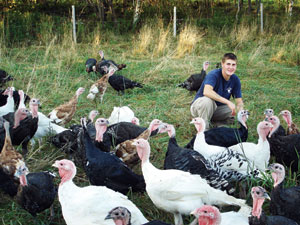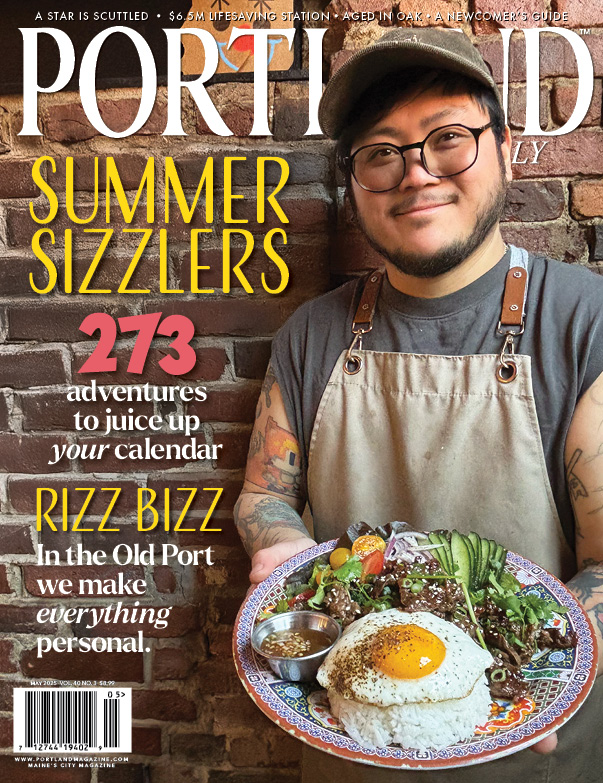November 2009
It’s no longer good enough to ‘break out the good stuff’ for the holidays. Now you have to order a special bird, too!
 History is alive in an edible way on a cheerful 20-acre farm atop Kilby Ridge in Dennysville. All around the bright yellow farmhouse are gardens full of exotic heirloom vegetables–Flashy Trout’s Back lettuce, Irish Cobbler potatoes, Musselburgh leeks, Fortex beans, Bantam corn, Red Beard onions, Chestnut garlic, and more. Under the Sheep’s Nose and Yellow Transparent apple trees graze Icelandic sheep, another antique variety. And in pens out by the old barn, Narragansett turkeys with their bold black and white plumage strut and banter in their gobbledy sort of way.
History is alive in an edible way on a cheerful 20-acre farm atop Kilby Ridge in Dennysville. All around the bright yellow farmhouse are gardens full of exotic heirloom vegetables–Flashy Trout’s Back lettuce, Irish Cobbler potatoes, Musselburgh leeks, Fortex beans, Bantam corn, Red Beard onions, Chestnut garlic, and more. Under the Sheep’s Nose and Yellow Transparent apple trees graze Icelandic sheep, another antique variety. And in pens out by the old barn, Narragansett turkeys with their bold black and white plumage strut and banter in their gobbledy sort of way.
The Willises, who own and run the farm, followed their taste buds to this place. Mark, 40, was a counterintelligence agent and software programmer living in Virginia; his wife, Violet, 41, specialized in late 18th and early 19th century fashion. “We’d started a garden and a small orchard, growing some heirloom fruits and vegetables, raising some chickens, but we knew we wanted more,” says Mark. Finding the most flavorful ingredients and cooking them well “became my passion,” Violet adds. “After we ate a heritage turkey, we loved it so much we knew we had to raise some ourselves.”
When they found this 1820 farm in Washington County three years ago, it seemed like the perfect place to take their vision of culinary excellence from pasture to plate. “The Narragansetts were the first bird developed in Colonial America,” says Mark. “It’s something that would have been raised on this farm when it began, and the turkey flavor is really great.”
The Willises are among a growing number of Mainers who say the heritage breeds are moister, chewier, more intensely flavored, and healthier than the standard, factory-farmed turkeys sold in most grocery stores. They have names like Royal Palms, Bourbon Reds, Bronzes, White Hollands, Slates, Buffs, Chocolates, Cinnamons, Blacks, and Narragansetts. Their plumage is a decorative array of reds, browns, blacks, whites, and blues, with extravagant tail feathers. Their taste and texture, as well as their behavior, leave the common industrial turkey–generally known as the Large White–in the barnyard dust.
You could think of the Large White as the Jane Russell of the turkey world. It was developed in the 1940s and ‘50s, the era of mass industrialization of American agriculture. “Chefs and restaurant owners wanted to be able to cut lots of fat slices of meat off the carcass, so factory farms started breeding turkeys with bigger and bigger breasts,” says Robert O. Hawes, a retired professor of animal and veterinary sciences at the University of Maine at Orono and author of a book on domesticated turkeys called Birds of a Feather.
The effort was innocent enough at first, Hawes says. But soon the birds developed such big breasts “that they couldn’t fly or even walk without tipping over. Their legs became too weak to support all that body weight.” If they wanted to get romantic, those big awkward breasts got in the way. They had to be artificially inseminated.
These bionic birds were efficient eating machines that could be raised in close quarters and fattened quickly. But their flesh became increasingly dry and bland. They needed antibiotics to ward off disease, which has begun to worry consumers.
Heritage turkeys, by contrast, still retain much of their wildness. They can fly and mate and roost in trees. They forage for their food. When they’re well-cooked, they have a nutty, pure turkey taste and a fine graining that discriminating eaters appreciate.
In one recent test in Virginia, 70 chefs, food writers, and other food professionals compared a Large White turkey and eight heritage varieties prepared exactly the same way, evaluating each one for flavor, texture, tenderness, smell, and appearance. All eight heritage birds ranked ahead of the industrial turkey, a Butterball. Judges found the Large White to be soft and bland, almost mushy by comparison.
The rub, alas, is the cost. With prices ranging from about $3 to $6 a pound, the heritage birds have a tough time competing at the cash register. Still, owners of the roughly half-dozen farms that raise them in Maine say they have no problem selling what they produce, especially as a Thanksgiving treat.
Those who buy them also have the pleasure of getting to know an interesting group of farmers, who in some ways are as exotic as the turkeys they raise. In addition to the Willises, these farmers include a farmer-framer who specializes in gold-leaf work, a former crane operator, a vegetarian, a nurse, and a blind farmer who doesn’t let his disability stop him from marketing his birds. Some, like Kathy Shaw of Auburn, often take young turkeys with them to farmers’ markets so consumers can see them alive. Others, like the Willises, invite the public to observe their operation first-hand.
Compared to the Large Whites, which “seem like grumpy old men standing around their feeders, just waiting for the food,” according to Hawes, the heritage birds “are like school boys running along the fence, gobbling at you and each other, flying on top of their shelters.” They’re curious, intelligent birds with lots of personality. “They will get to know you, come and sit right next to you,” says Shaw. “I had one who liked to sit in my lap. I didn’t mind so much, except that he was kind of stinky.”
Because the heritage turkeys typically are smaller, leaner, and more muscular than the Large Whites and have a more even balance of white and dark meat, they require different preparation. Violet Willis recommends roasting them at 350 degrees for 15 minutes per pound, with tin foil covering their legs until the last half hour or so.
Lawrence Klang, executive chef at Natalie’s in the Camden Harbour Inn, served Black turkeys last year and hopes to have Bourbon Reds and Royal Palms on this year’s menu as well. He advises brining the bird in a cider-based liquid. Then he removes the legs and thighs and debones them, replacing the bones with a stuffing made from cubes of bread lightly fried in olive oil, fried chopped gizzards, apples, leeks, and perhaps a little Calvados. He gives this a quick sauté and then cooks it at 350 degrees. He roasts the breast separately at 425 degrees for the first half hour, then drops the temperature to 325 degrees. He also recommends about 15 minutes in the oven for every pound of turkey. He says he likes the flavor of the heritage turkeys so much that last year he cooked one for his own family, as well as serving them at the restaurant.
It wasn’t so long ago that some of these birds were on the endangered list. In 1997, a national survey of heritage turkeys in hatcheries around the U.S. found only three female Narragansetts in existence, four White Hollands, and 60 Slates. Now, with support from groups like the American Livestock Breeds Conservancy, the Maine Alternative Poultry Association, the Heritage Turkey Foundation, and the Slow Food movement, as well as consumers wanting healthier, tastier turkeys, they’re having a marked resurgence.
“I don’t know if heritage has become the new buzzword,” says Shaw. “But these birds were almost forgotten, and now they’re coming back.
“Think of the Large White as the Jane Russell of the turkey world–a product of post-war mass industrialization.”
Emma’s Family Farm
Steve and Rose Hoad
135 Windsor Neck Road, Windsor
445-2141
Kilby Ridge Farm
Mark and Violet Willis
109 Main Street, Dennysville, 726-4765
Ledge hill Farm
Johanna Moore
201 Ryder Road, Farmingdale, 582-6512
Valley View Farm
Kathy Shaw
1200 Soper’s Mill Road, Auburn, 320-1969
Fair Share Farm
Michael Small
641 Canton Pt. Road, Canton, 597-2746
Frelsi Farm Icelandics
Elaine Clark
P.O. Box 54, Limerick, 793-4640





0 Comments